Since the days of the Boston Tea Party, hardy souls may have gathered in February on the banks of the Charles to test themselves in rowing matches, but it wasn’t until the invention of the kilometer, unitards, and the Concept2 rowing machine (henceforth, the erg) that things really got rolling. The CRASH-B world indoor rowing championship is a 2K time trial at which some 2,100 competitors come together at Boston University’s Agganis Arena to leave their marks. Over the course of the grueling 9.9 furlong course, most will cram a year’s worth of physical suffering into a tidy 6 to 9 minute package. You’re guided in this struggle by (1) a digital console that shows distance remaining, stroke rate, and current pace (in terms of a 500 meter split time), (2) an analog coxswain that shows people to be inherently sadistic, and (3) a rail that constrains your longitudinal motion. The first two will mock you and lie to you, while the third… well, that’s just tempered steel.
The 2K time trial is notoriously difficult – too long to be a sprint, too short to be an endurance event, and too dynamic for the use of supplemental oxygen. This event separates the men from the boys, but it doesn’t stop there. It further separates the boys into a complex sub-ranking, ranging from Power Lad to Droopy Toddler. Figuring the trial would once again spit me out somewhere near the end of that spectrum, I came prepared with a binky and a change of clothes.
When asked why he wanted to climb Mount Everest, George Mallory famously quipped “Because it’s there.” Lacking any sensible response – how could there possibly be one? – I’d give the same reason for my participation in the CRASH-B’s. When reminded that Mallory’s dessicated corpse was discovered 75 years later, somewhat short of “there”, I’d probably grow hostile and refuse to answer any more of your stupid questions. But after a few minutes, I’d sheepishly relent, because nobody else ever wants to talk to me. From a tempestuous start, we’d forge a short-lived life-long friendship.
Let’s go over the rules. The horn goes off (there is no horn). You row. You’re not allowed to deliberately spit on your competitors, but if you’re not inadvertently showering your neighboring rowers with some combination of bodily fluids (tears are my serum of choice), you’re doing it wrong. There will be a lot of yelling, but you won’t know if it’s coming from you or someone else. Despite all evidence to the contrary, after a finite amount of time you will finish. Finally, you will swear off ever rowing again. Period.
This was to be my third year at the CRASH-B’s. I had pulled a 6:43.0 in my inaugural effort, improved to 6:31.4 as a sophomore, and was looking to break the 6.5 minute mark in 2015, and to perhaps also break into the top ten of my 40-49 age group. That was going to take some serious training. The gods were smiling on me, as a nagging kayak-related injury chased me off the water and onto my basement erg by September. I still had a few working parts left, and I’d be damned if I wouldn’t also grind those down by Christmas.
For the first few months, my focus was on building aerobic endurance through long and leisurely-paced sessions. I tempered the tedium – while also improving my mind – by streaming endless hours of culturally sophisticated Netflix programming. Turns out that’s Gopher’s real name was Burl! By December I was ready to trade in some of my slow rows for something a little more arduous – a couple of interval sessions a week. Mary Beth decided to start training at this point too, leading too many drunken fisticuffs over who would get the erg that evening.
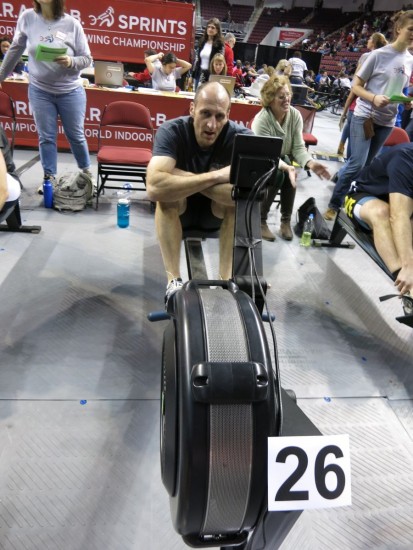 For the next six weeks or so, I was living the dream. Maybe not the dream – after all, I wasn’t yet best friends with Steve Buscemi and was spending a lot of time gasping for air – but life was pretty good. My interval times were falling faster than Bill Cosby’s ticket sales. By January I was in better shape than I had been at the 2014 race, with 8 weeks of training still on the table! I started dropping my CRASH-B goal. 6:28? 6:25? 6:23?!? Narrative etiquette requires that I conclude this paragraph with a declarative statement of hyperbolic optimism. So… Nothing could stop me!
For the next six weeks or so, I was living the dream. Maybe not the dream – after all, I wasn’t yet best friends with Steve Buscemi and was spending a lot of time gasping for air – but life was pretty good. My interval times were falling faster than Bill Cosby’s ticket sales. By January I was in better shape than I had been at the 2014 race, with 8 weeks of training still on the table! I started dropping my CRASH-B goal. 6:28? 6:25? 6:23?!? Narrative etiquette requires that I conclude this paragraph with a declarative statement of hyperbolic optimism. So… Nothing could stop me!
At 7:42 on the evening of January 24th, the flywheel of my world came to a shuddering halt. After nearly two months of steady improvement, I suffered an epic meltdown during an interval session. It wasn’t just that I ran up against a physical wall (that is, a metaphorical wall, physically), but that something snapped mentally (also metaphorically, I hope). I lost the willpower to continue pushing through discomfort levels I had once laughed at (in a queasily maniacal way, granted). I nominally completed my session that night, but my relationship with intervals – formerly tempestuous, but built on a foundation of mutual respect – had taken an ugly turn. What I had hoped was a one-time anomaly repeated on me in the next work-out, and then the one after that.
I became haunted by the specter of looming intervals. Taking a cue from Homeland Security, I initiated a color-coded “Dread Level” plan. On days scheduled for easy workouts, I’d perhaps be at Dread Level: Yellow. On interval days, however, the Red banner of doom would be waving over me from the moment I awoke. I’d spend the day in nauseating contemplation of the forthcoming suffering and verbal abuse (Mary Beth had started piling on), and was seldom disappointed in my fears. My interval performance was getting steadily worse. My confidence was shot. My cousin Toby kept calling to ask about borrowing more money. That may have been unrelated.
Despite my struggles – or perhaps because of them – the morning of the CRASH-B’s arrived. I had peaked weeks too early, but nevertheless had a reasonable shot at bettering my 2014 time if I could keep the hounds of doubt at bay. On the drive down to Boston, I reviewed my race plan with Mary Beth, who would once again be serving as my Sherpa – guiding me to my best possible time via the use of strategically applied insults and surreptitiously delivered “vitamin” shots. Whereas last year I had developed a detailed stroke plan that made the invasion of Normandy look like a slapdash affair, this year I was keeping it simple: pull at 1:36.5 pace until rigor mortis set in. Assuming I got to the finish line prior to my expiration date, that would put me at 6:26 flat.
A cox has free rein to apply whatever motivational leverage she feels will pry another tenth of a second out of your carcass. However, in past trials I’ve heard a few over-the-shoulder phrases that I believe may have had the opposite effect. So during our strategy pow-wow, I suggested Mary Beth might want to stay away from the following:
- “You’re almost an eighth of the way there!”
- “Is that blood?”
- “Why, no… I’m not doing anything after the race.”
- “The custodian says he’d like to clean up now.”
- “I never noticed that mole before.”
- “Noooo!!!”
- “Remember, your speed increases as the cube root of power exerted!”
- “Why can’t you be more like your brother?”
- [Disappointed silence]
- “There’s always last year.”
- “Stroke! Stroke! Ooh, a nickel!!!”
- “You’ve just aged into a new category.”
She said she’d do her best, but wouldn’t make any promises.
We arrived at Agganis Arena (its summit barely peaking over the snowy wasteland that was once Boston) just in time to see the junior women’s world record being shattered. The air crackled with excitement – cheers echoing through the hall over the soft thunder of imploding rowers. During warm-ups we ran into Indomitable Roger Gocking, who earlier in the day had himself toyed with breaking the lightweight men’s world record for his age group. Ultimately, he looked inward and decided that the journey was reward enough, leaving the record for another day. Also, he erred slightly on his pacing and ran his fuel mixture a little lean.
A brief warm-up later, I discovered myself unexpectedly perched on my erg. So soon… I had been in the Red all day, but as my last minutes ticked away, my level of apprehension over the coming torment reached unprecedented levels. I was operating at Dread Level: Bile. It seemed unimaginable that was a voluntary endeavor. Looking around with wild eyes at my impeccably toned and spandexed competition, I desperately sought a reasonable excuse to bow out. Death in the family? Unfortunately, my relatives were all clinging selfishly to life. Sudden-onset dysentery? I didn’t want to ruin everyone’s day. Robot uprising? Even if I could arrange it in the next couple of minutes, our new overlords would probably sentence us to a punishment of endless 2K time trials anyway. My three best options exhausted, I resigned myself to the inevitable.
In a trice, the start fell roughly upon us. Sit Ready. Attention. Row.
At the beginning of last year’s race, I had enthusiastically launched off the back of the sliding seat in an apparent effort to cripple myself. Determined to avoid repeating this drama, I eased out from the dock as if ferrying a parasoled duchess across the Avon. Perhaps we’d stop for some scones mid-river. I was concentrating on not spilling a drop of tea when the salty oaths of my coxswain reminded me that while my cox was indeed a woman, she was no lady. So much for the scones. With no legal recourse, I responded to her verbal lashing and upped my pace…
… and entered into a wondrous zone of infinite possibilities. The first 150 meters of a 2K is a magical utopia, where all is sweetness and rainbows, and friendly woodland critters caper about excitedly. You’re 4 years old again, and you cannot believe how fast you’re running across the lawn. Those scores of intervals that established your performance limits – those were the anomalies, while this is your true natural pace. Deep within your mind, one last spark of rationality suggests that maybe that’s the adrenalin talking, but, not wanting to have his glasses broken yet again, tries to play it off as a joke when stared down by his bullying, short-sighted brainmates.
One of the advantages of doing a 2K is that – for a span of a few minutes – you get to abdicate your normal mental responsibilities. You’re there to row, not to solve the Middle Eastern crisis, worry about work, or remember how to breathe. That’s what your coxswain is for (and I look forward to hearing what Mary Beth came up with regarding Israeli-Palestinian relations). I emptied my mind and let MB take the wheel: “Stroke. Breath. Stroke. Heartbeat. Stroke. Multi-national accord. Stroke.” It worked. As the words flowed through me at an almost subconscious level, I eased back and settled at my target pace, although I do now have an unexplainable urge to paint the living room.
Since the erg monitor doesn’t show pace to tenths of a second, I made a game of trying to alternate consistently between 1:36 and 1:37 to hit my target. Four strokes at 1:36 then four strokes at 1:37. Perhaps not the most exciting game ever, but any distraction from the growing build-up of lactic acid and irreversible lung damage was welcome. As the meters slowly unrolled, I found that all those 1:36’s weren’t sitting that well with me. Too bitter. I threw in a few more 1:37’s to sweeten the mix. Delicious! Following the unimpeachable logic of this slippery slope, by the 1000 meter mark I had completely flushed all of those foul 1:36’s out of my system and was throwing in the occasional 1:38 for seasoning.
When talking about the halfway point of a race, it’s important to distinguish between the halfway point as measured by an external observer and the halfway point as measured by someone traveling within the sliding confines of the erg itself. For the former, the race is obviously evenly divided into two 1K halves. For the racer, however, time and distance take on a taffy-like consistency. Although the world’s preeminent physicists and confectioners have explored this phenomena, none have been able to explain how the halfway point can indefinitely recede as one continues to row. A young Albert Einstein believed that the dilation of time had something to do with flywheels and reciprocating frames of reference, but ultimately abandoned this conundrum to work on simpler problems.
With the halfway point just ahead, I muddled through to 1500 meters in the general vicinity of 1:37. The final 500 meters of a 2K is a shadow realm, where all is sorrow and pain, and vicious woodland fiends tear at your soul. Approaching this dark kingdom, I quickly triangulated a new course that would allow me to skirt the murky depths. A heading of, say, 1:45 should do it. I began my course correction when a malevolent snarl from behind froze my heart. I had forgotten – this wasn’t my vessel to captain. “May the devil be damned! We row through the Heart of Darkness!” roared my coxswain. “Stroke! Stroke! Stroke! Breathe tomorrow, worm! Stroke!” The leg irons tearing at my flesh, the deep reverberations of the drums numbing my spirit, the fetid stench of my fellow oarsmen overwhelming my senses… I had no choice but to comply.
We plunged ahead at 1:36, foam spraying from my turbulent mouth. Time dilation in full force, I was able to truly savor the piquant agony of each hour-long stroke. With 300 meters to go, my overtaxed muscles mutinied and staged a sit-down strike to demand better working conditions. Sinew and grit would have to see me through for the remainder. A hundred meters later, grit tendered its resignation (blind to the irony, apparently). I was almost halfway home, but could only watch helplessly as the shadowy murk closed around me, sucking all hope from my spleen (modern medicine, bah). I was destined to wander the darkness for all eternity. Even my hallucinated beacon of hope, Mr. Flappers, couldn’t save me this year. All was lost.
Or was it? Yes… all is lost. But maybe not? Irretrievably lost. What if I… Look, I’m telling you. It’s lost. You’re lost. Give it up. Yeah, but… I can see that I’m going to have to spell this out for you. You’re exhausted. Ever fiber of your being is hoarse from screaming in pain. You don’t even care about finishing anymore. It. Is. Lost. But doesn’t the mere existence of this inner dialog indicate that I do indeed care about finishing? That I have some fight left in me? OK Descartes, then how do you explain the fact that you stopped rowing 15 seconds ago. Well I… wait. What? That’s right, sucker. While we’ve been arguing you finished! Or did I?
I did. Even the longest night comes to an end, and I had weathered through to dawn. While tucking my tattered lungs back inside my body, I struggled to make sense of the jumble of swirling numbers on the console of my erg. Only after blood flow had been restored to the non-essential organ in my head was I able to make sense of the display. 6.26.3. Sweet tears of joy flowed down my cheeks. Only to be replaced seconds later with bitter tears of frustration once Mary Beth had helpfully reminded me that Joe Glickman once pulled a 6:20. You can bet that no-account show-off would have a good laugh at my expense that night! Nevertheless, nobody can take away the fact that I had improved my personal best by 5 seconds. At least not until the blood test results come in.
Mary Beth’s heat was to start in less than twenty minutes, so shoving her aside, I rushed to find a secluded area for my vocal exercises. It was with unfettered glee that I approached my reciprocal coxswain duties. After locking down an 8:21.0 last year, Mary Beth was looking to cut that in half for 2015. That seemed a bit optimistic, so we haggled a while before settling on something in the 8:15 range. She’d aim to maintain a steady 2:03 pace throughout.
After a few minutes of practice strokes to get me in the drill sergeant frame of mind, Mary Beth settled in for the start. Although she claimed to be nervous, she acted more like she was at Dread Level: Kitten. I was still at a reddish Orange. Then it was time. Sit Ready. Attention. Row. I started out of the gate strong, with Mary Beth at my heels. After the first few moments of frenziedly barked instructions, I settled into a more sustainable rhythm. I needed to remain within myself if I was going to make it.
Meanwhile, Mary Beth had wisely decided to stick with her inner coxswain rather than start at 130 strokes per minute as her outer coxswain was advising. By the time I had calmed down and gotten back to the plan, she was a few hundred meters into the race. At the halfway point (see above), Mary Beth was right on target at a 2:03 pace, but some cracks were starting to show in both her form and my voice. Whereas last year she had gone out much too slow and then accelerated through the last 500 meters with the flywheel spewing dense clouds of smoke, this year she had gone out perhaps a shade too fast and was now struggling to maintain her momentum.
It was difficult to watch as Mary Beth waged a no-holds-barred, bare-knuckle fight with herself to maintain pace. Not because of any empathy, but because I was still feeling a little light-headed and nauseous from my race. I’m proud to say that Mary Beth and I both powered through adversity, retaining a sub-2:04 pace and my lunch, respectively. With a time of 8:13.3, she had shaved 7.7 seconds off of her previous best time.
We stuck around to watch the Open class competitors in the final races of the day. This wasn’t a choice, but a necessity – neither of us could remember how our legs worked. We were rewarded with a spectacular race by Cuban rower Angel Fournier Rodriguez, who staged a come-from-behind victory by dropping his pace to jaw-dropping 1:20 with 800 meters left in the race. Finishing at 5:45.9, Señor Rodriguez had been generating an average of 550 watts. I was only putting out 388 watts during my effort. It’s nice to know that there’s some room for improvement in 2016.
Here are links for the full championship results, my group results, Mary Beth’s group results, an animation of my heat, and an animation of Mary Beth’s heat.
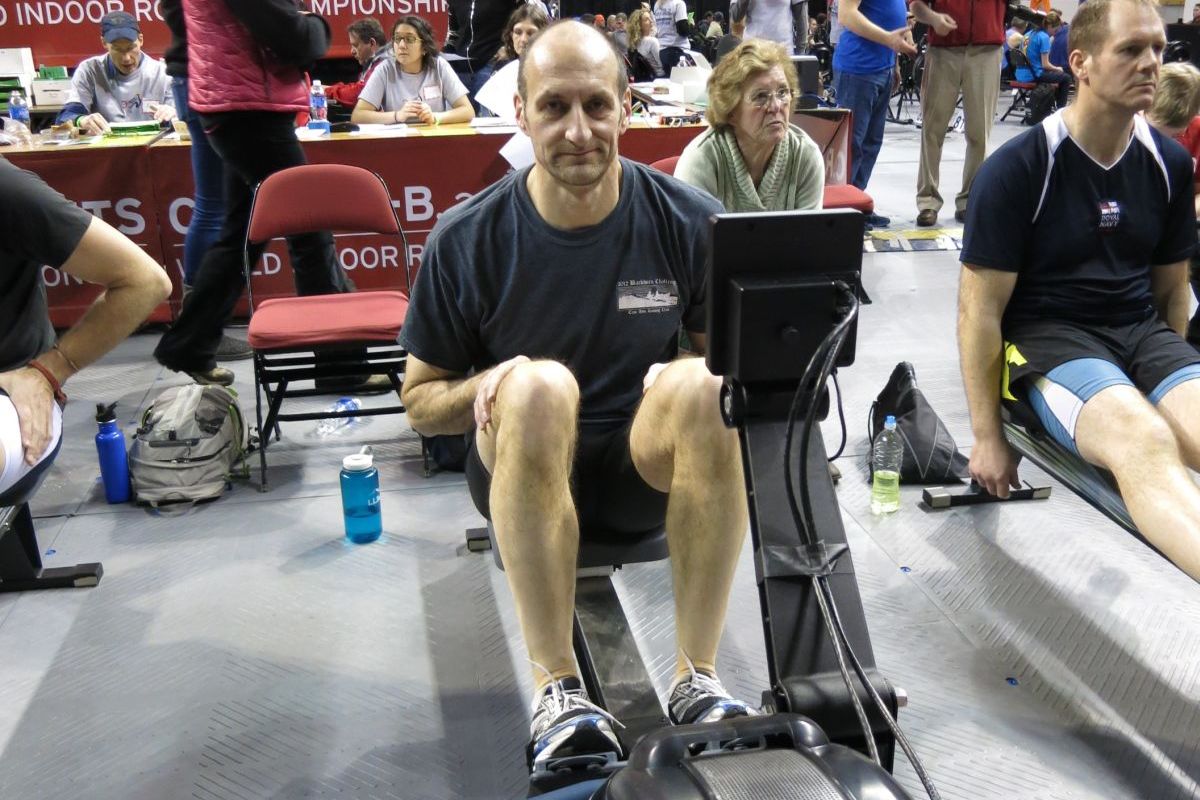
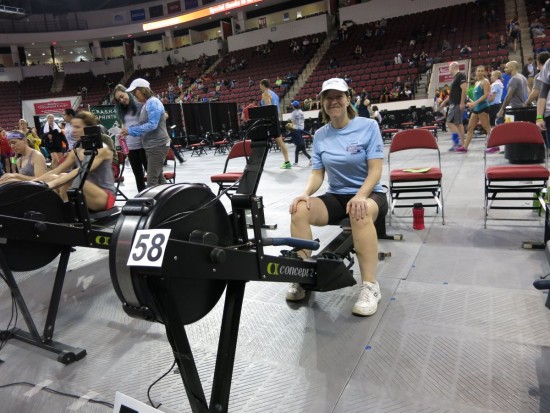
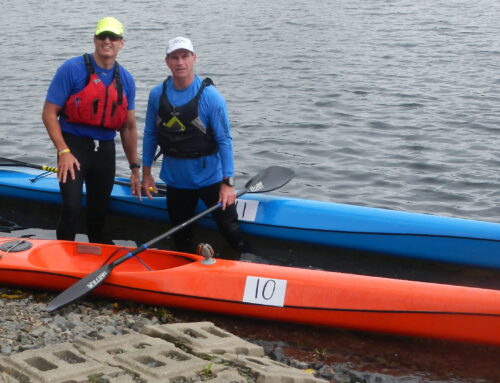
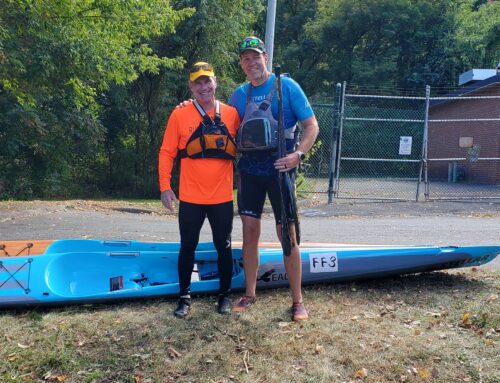
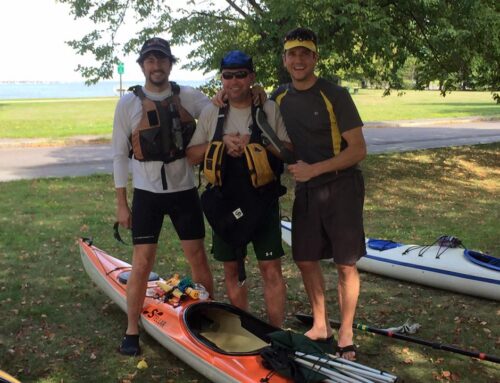
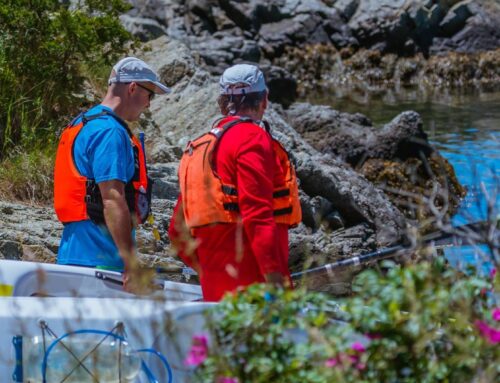
Leave A Comment
You must be logged in to post a comment.